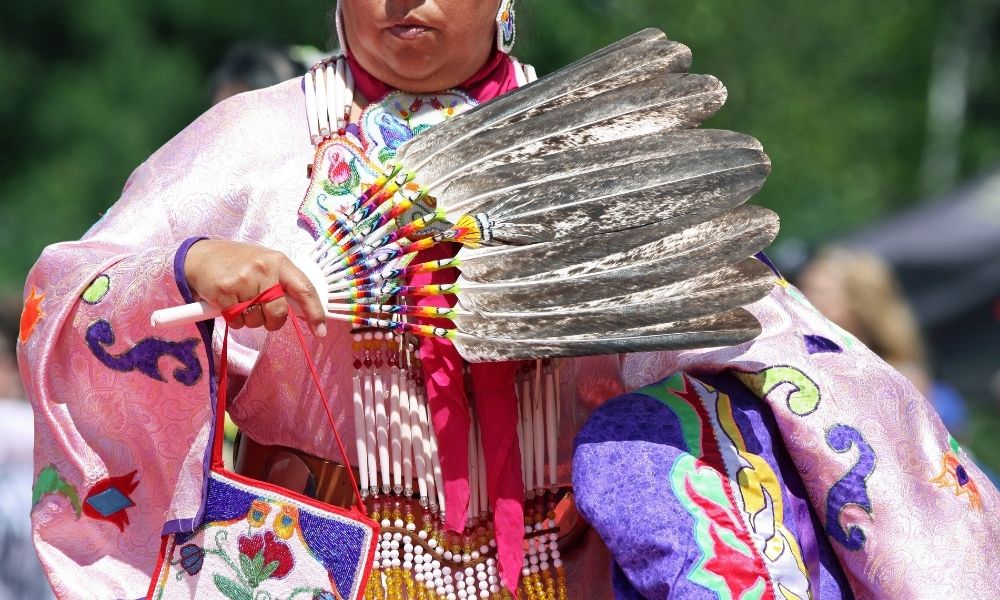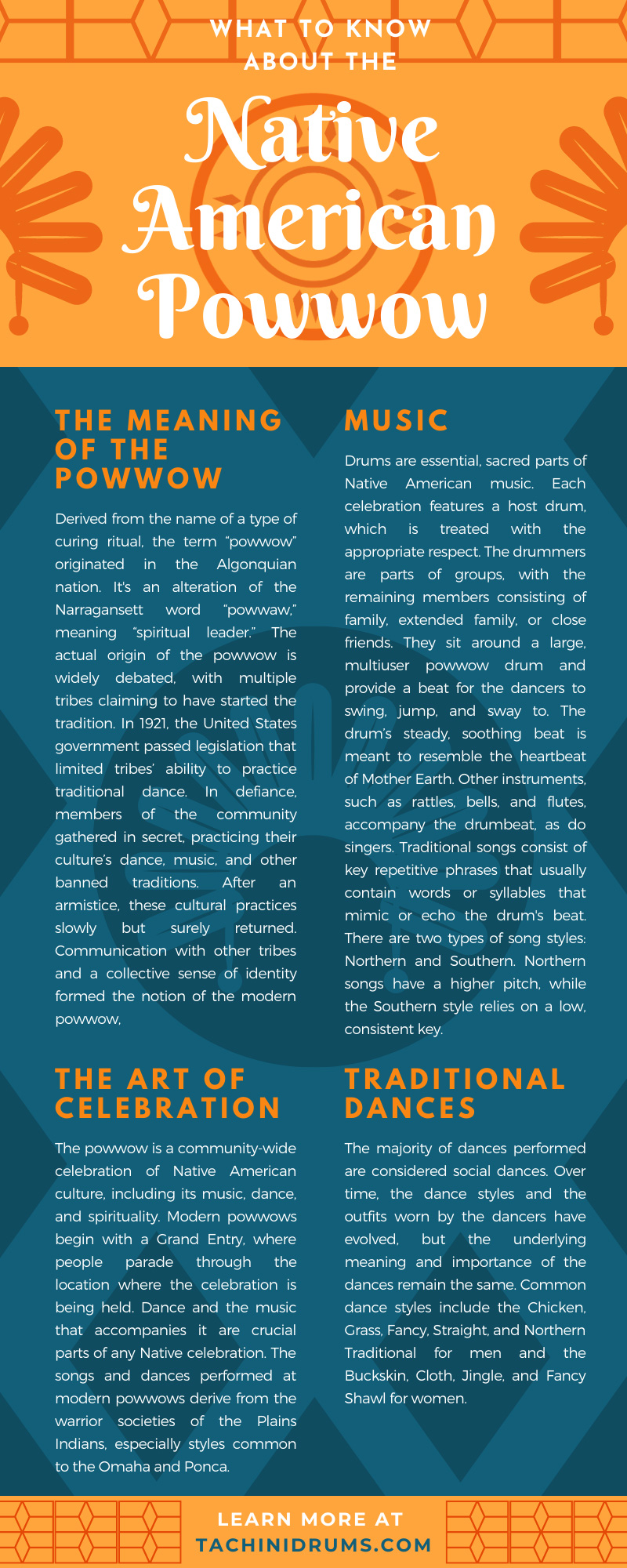Top Authentic Native American Drum Accessories
Native American drums are sac..
 ">
">The powwow is a grand celebration of culture, where members of diverse, indigenous tribes dance, sing, socialize, and honor the traditions of their ancestors. These events can be public or private, and they vary in length from single, one-day events to week-long endeavors. Here’s what to know about the Native American powwow, including its origin, its meaning, and the traditional activities that occur during the event.
Derived from the name of a type of curing ritual, the term “powwow” originated in the Algonquian nation. It’s an alteration of the Narragansett word “powwaw,” meaning “spiritual leader.” The actual origin of the powwow is widely debated, with multiple tribes claiming to have started the tradition. During the late nineteenth and early twentieth centuries, public dances similar to the ones performed at modern powwows were common in the Great Plains.
In 1921, the United States government passed legislation that limited tribes’ ability to practice traditional dance. In defiance, members of the community gathered in secret, practicing their culture’s dance, music, and other banned traditions.
After an armistice, these cultural practices slowly but surely returned. A sense of camaraderie with members of other tribes was fostered, and tribal identity began to meld together. Communication with other tribes and a collective sense of identity formed the notion of the modern powwow, where multiple tribes band together and celebrate their shared history.
The powwow is a community-wide celebration of Native American culture, including its music, dance, and spirituality. Modern powwows begin with a Grand Entry, where people parade through the location where the celebration is being held. Flags—including the U.S. flag, tribal flags, the POW flag, and the Eagle Staffs of various Native nations—are carried in by veterans.
After the veterans, other important guests—such as tribal chiefs, elders, and organizers—walk in. Following them are the male dancers and, shortly afterwards, the female dancers. A song is sung, a prayer is made, and the dancing begins.
Dance and the music that accompanies it are crucial parts of any Native celebration. The songs and dances performed at modern powwows derive from the warrior societies of the Plains Indians, especially styles common to the Omaha and Ponca.
Drums are essential, sacred parts of Native American music. Each celebration features a host drum, which is treated with the appropriate respect. The drummers are parts of groups, with the remaining members consisting of family, extended family, or close friends. They sit around a large, multiuser powwow drum and provide a beat for the dancers to swing, jump, and sway to. The drum’s steady, soothing beat is meant to resemble the heartbeat of Mother Earth. Other instruments, such as rattles, bells, and flutes, accompany the drumbeat, as do singers.
Traditional songs consist of key repetitive phrases that usually contain words or syllables that mimic or echo the drum’s beat. There are two types of song styles: Northern and Southern. Northern songs have a higher pitch, while the Southern style relies on a low, consistent key.
The majority of dances performed are considered social dances. Over time, the dance styles and the outfits worn by the dancers have evolved, but the underlying meaning and importance of the dances remain the same. Common dance styles include the Chicken, Grass, Fancy, Straight, and Northern Traditional for men and the Buckskin, Cloth, Jingle, and Fancy Shawl for women. Other dance styles, such as the Smoke, Bird, or Gourd Dance, are performed depending on the region in which the powwow is being hosted.
Another good thing to know about the Native American powwow is how some of the most popular dances are performed:
The Grass Dance is a competitive form of Northern dancing that involves foot tapping and wide, swinging arm movements. The traditional outfit consists of a shirt, pants, and decorated belts, side tabs, armbands, cuffs, apron, headband, and moccasins. There isn’t much loose ornamentation. Ribbons, fringe, and a broach feather are the only mobile parts of the outfit.
The Fancy Dance is a highly popular style of dance with two basic steps: the simple step, where dancers prance around a central drum, and the contest step, which involves fast, intricate footwork. The traditional outfit consists of loom-beaded suspenders, belt cuffs, armbands, a headband, and more. The designs of these garments usually match, and the cloth is covered in beadwork and feather bustles.
The Northern Traditional Dance is a modern, dynamic men’s dance that mimics the movement of a prairie chicken or, as some describe it, a warrior searching for his enemies. The traditional outfit consists of a broach made from porcupine and deer tail hair; a shirt and pants; and a breastplate, choker, hair pipes, a cloth or leather vest, and more. Dancers also carry wing fans, pipe bags, and dance sticks.
The Buckskin Dance is one of the oldest forms of women’s dancing. It’s slow and poised. Dancers circle a central drum, swaying, bobbing, and bending their knees to the beat. The traditional outfit consists of beaded buckskin dresses, fringed shawls, jewelry, breastplates, and either beaded hair barrettes or crowns.
The Cloth Dance is a slow, graceful dance consisting of gentle, swaying movements and the repeated tapping of feet. The traditional outfit consists of a cloth or wool dress, high-top moccasins, a fringed wrap, a breastplate, either a choker or scarf, and a belt with an awl case, lite bag, and tobacco bag attached. Dancers also carry a fan, purse, and shawl.
The Jingle Dance is a lively woman and girl’s dance performed in tune with the drum’s beat. Dancers keep their movements low to the ground, kicking and bouncing to the music. They move in a zigzag pattern, which represents a person’s journey through life. The traditional outfit consists of a dress with rows of ziibaaska’iganan (metal cones) sewn into the cloth; a belt; and decorative moccasins.
Tachini Drums is your home for high-quality, authentic Native American powwow drums for sale. Browse our inventory, and let our products connect you with the heartbeat of Mother Earth.
